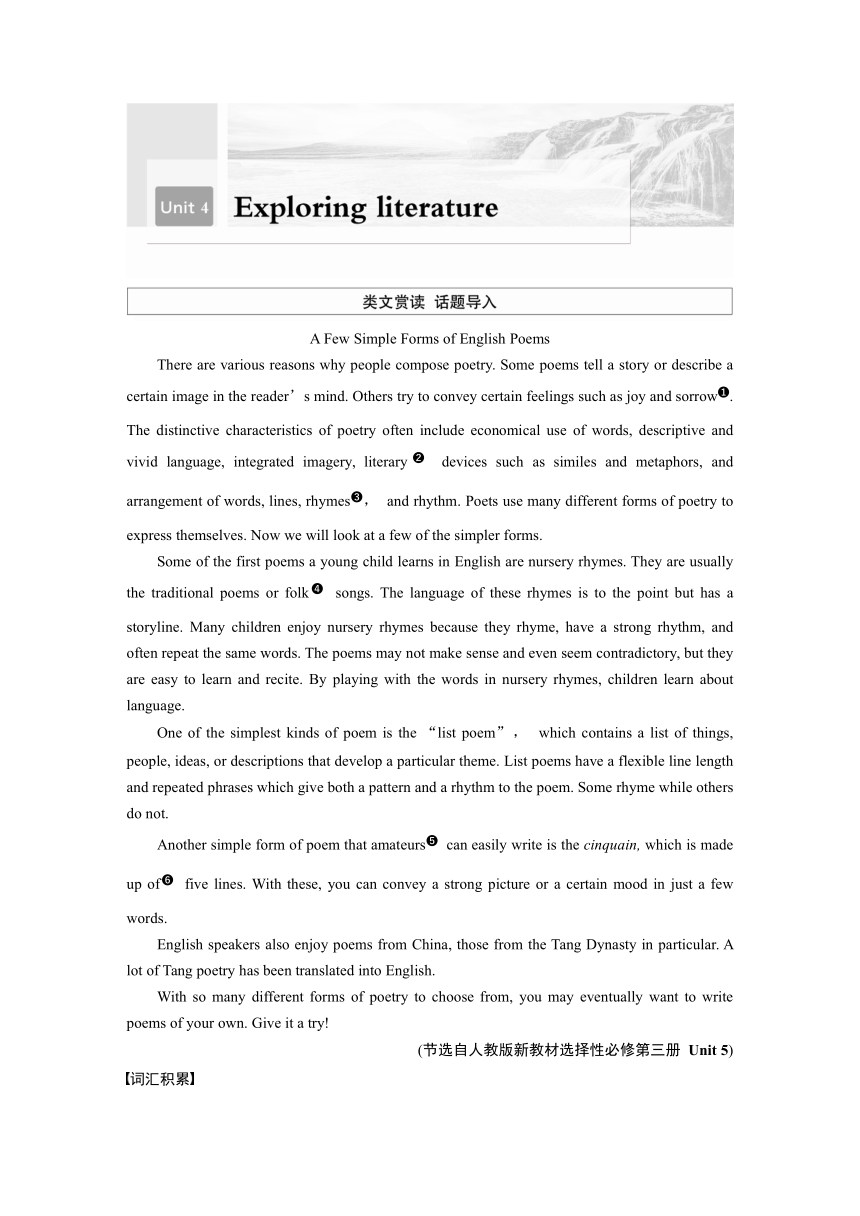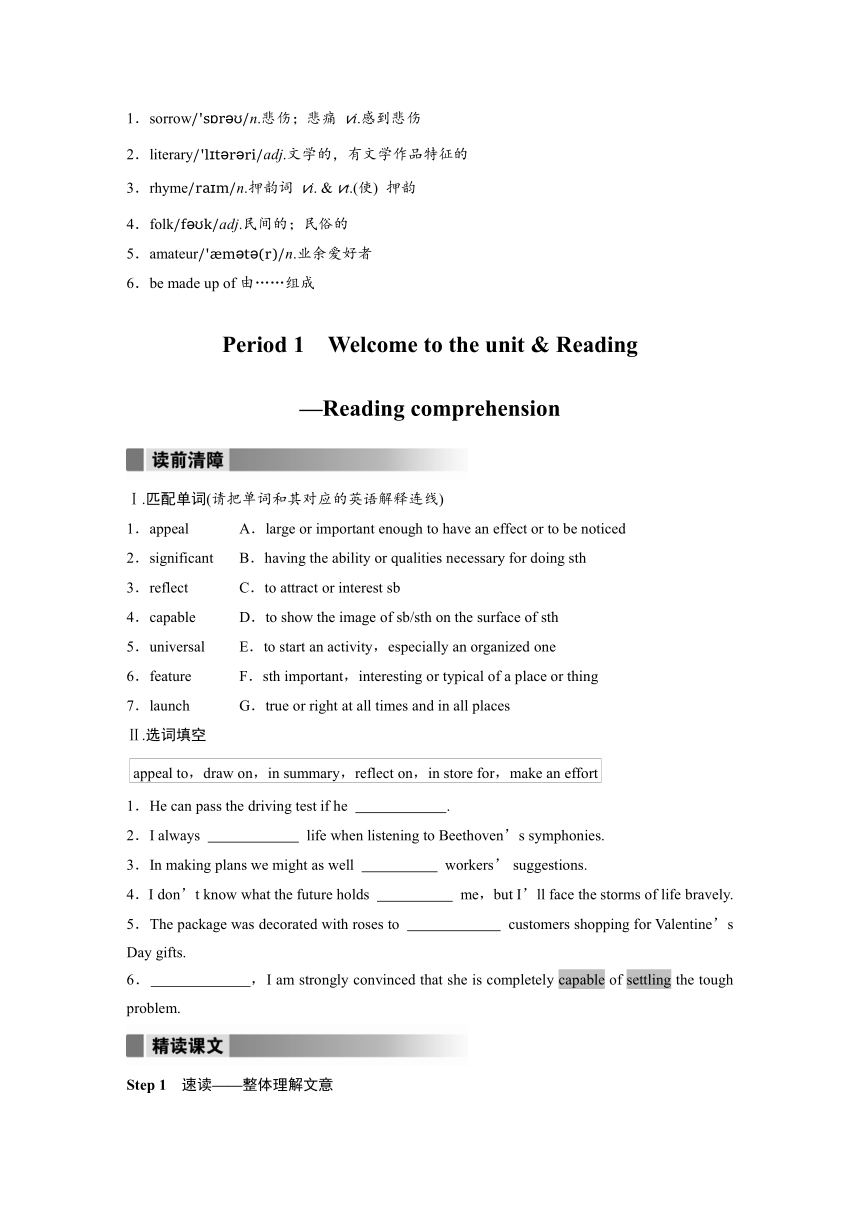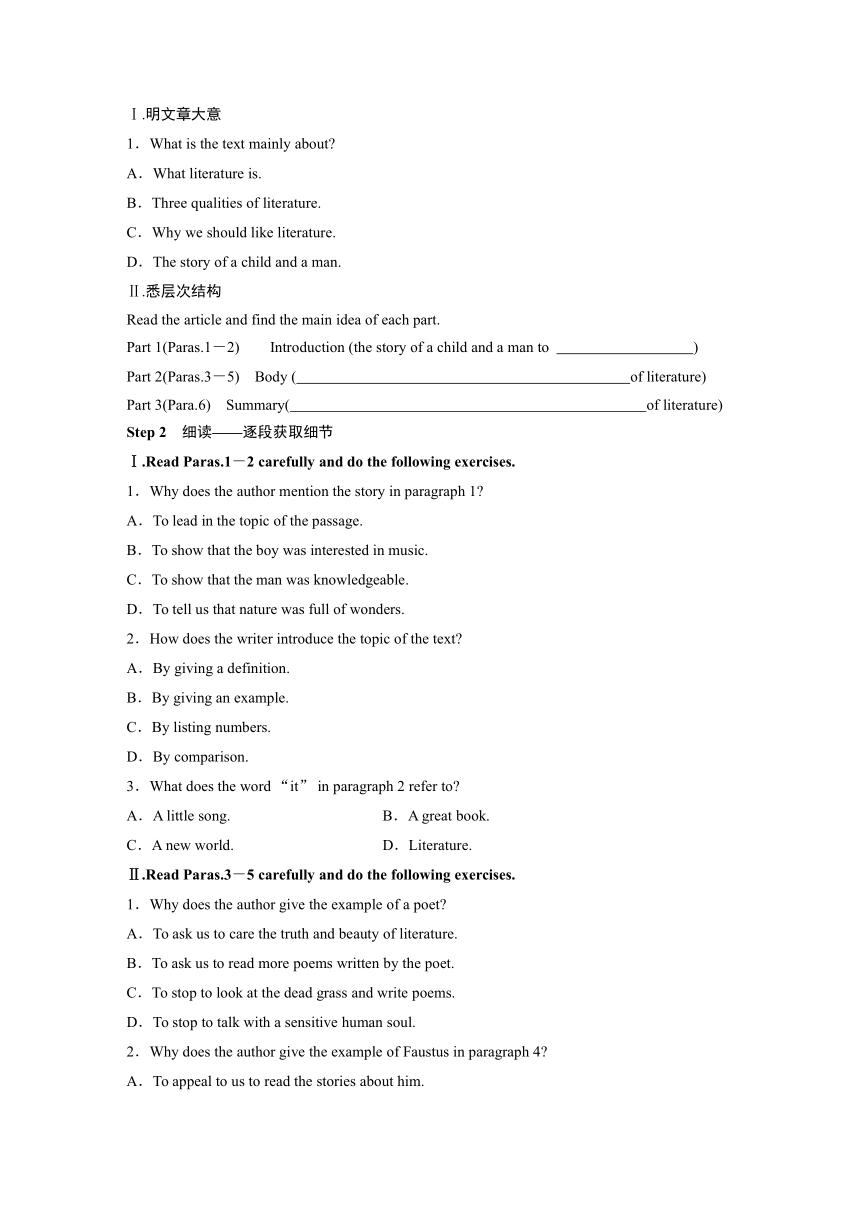译林版(2019) 必修 第二册Unit 4 Exploring literature Reading—Reading comprehension 学案(含答案)
文档属性
| 名称 | 译林版(2019) 必修 第二册Unit 4 Exploring literature Reading—Reading comprehension 学案(含答案) |  | |
| 格式 | docx | ||
| 文件大小 | 1.7MB | ||
| 资源类型 | 教案 | ||
| 版本资源 | 牛津译林版(2019) | ||
| 科目 | 英语 | ||
| 更新时间 | 2023-08-27 22:59:55 | ||
图片预览



文档简介
A Few Simple Forms of English Poems
There are various reasons why people compose poetry. Some poems tell a story or describe a certain image in the reader’s mind. Others try to convey certain feelings such as joy and sorrow . The distinctive characteristics of poetry often include economical use of words, descriptive and vivid language, integrated imagery, literary devices such as similes and metaphors, and arrangement of words, lines, rhymes , and rhythm. Poets use many different forms of poetry to express themselves. Now we will look at a few of the simpler forms.
Some of the first poems a young child learns in English are nursery rhymes. They are usually the traditional poems or folk songs. The language of these rhymes is to the point but has a storyline. Many children enjoy nursery rhymes because they rhyme, have a strong rhythm, and often repeat the same words. The poems may not make sense and even seem contradictory, but they are easy to learn and recite. By playing with the words in nursery rhymes, children learn about language.
One of the simplest kinds of poem is the “list poem”, which contains a list of things, people, ideas, or descriptions that develop a particular theme. List poems have a flexible line length and repeated phrases which give both a pattern and a rhythm to the poem. Some rhyme while others do not.
Another simple form of poem that amateurs can easily write is the cinquain, which is made up of five lines. With these, you can convey a strong picture or a certain mood in just a few words.
English speakers also enjoy poems from China, those from the Tang Dynasty in particular. A lot of Tang poetry has been translated into English.
With so many different forms of poetry to choose from, you may eventually want to write poems of your own. Give it a try!
(节选自人教版新教材选择性必修第三册 Unit 5)
词汇积累
1.sorrow/'s r /n.悲伤;悲痛 vi.感到悲伤
2.literary/'l t r ri/adj.文学的,有文学作品特征的
3.rhyme/ra m/n.押韵词 vi. & vt.(使) 押韵
4.folk/f k/adj.民间的;民俗的
5.amateur/' m t (r)/n.业余爱好者
6.be made up of由……组成
Period 1 Welcome to the unit & Reading
—Reading comprehension
Ⅰ.匹配单词(请把单词和其对应的英语解释连线)
1.appeal A.large or important enough to have an effect or to be noticed
2.significant B.having the ability or qualities necessary for doing sth
3.reflect C.to attract or interest sb
4.capable D.to show the image of sb/sth on the surface of sth
5.universal E.to start an activity,especially an organized one
6.feature F.sth important,interesting or typical of a place or thing
7.launch G.true or right at all times and in all places
Ⅱ.选词填空
1.He can pass the driving test if he .
2.I always life when listening to Beethoven’s symphonies.
3.In making plans we might as well workers’ suggestions.
4.I don’t know what the future holds me,but I’ll face the storms of life bravely.
5.The package was decorated with roses to customers shopping for Valentine’s Day gifts.
6. ,I am strongly convinced that she is completely capable of settling the tough problem.
Step 1 速读——整体理解文意
Ⅰ.明文章大意
1.What is the text mainly about
A.What literature is.
B.Three qualities of literature.
C.Why we should like literature.
D.The story of a child and a man.
Ⅱ.悉层次结构
Read the article and find the main idea of each part.
Part 1(Paras.1-2) Introduction (the story of a child and a man to )
Part 2(Paras.3-5) Body ( of literature)
Part 3(Para.6) Summary( of literature)
Step 2 细读——逐段获取细节
Ⅰ.Read Paras.1-2 carefully and do the following exercises.
1.Why does the author mention the story in paragraph 1
A.To lead in the topic of the passage.
B.To show that the boy was interested in music.
C.To show that the man was knowledgeable.
D.To tell us that nature was full of wonders.
2.How does the writer introduce the topic of the text
A.By giving a definition.
B.By giving an example.
C.By listing numbers.
D.By comparison.
3.What does the word “it” in paragraph 2 refer to
A.A little song. B.A great book.
C.A new world. D.Literature.
Ⅱ.Read Paras.3-5 carefully and do the following exercises.
1.Why does the author give the example of a poet
A.To ask us to care the truth and beauty of literature.
B.To ask us to read more poems written by the poet.
C.To stop to look at the dead grass and write poems.
D.To stop to talk with a sensitive human soul.
2.Why does the author give the example of Faustus in paragraph 4
A.To appeal to us to read the stories about him.
B.To seek the answer to his question.
C.To prove that Helen is a beauty and heroine.
D.To tell that literature can inspire readers’ imagination.
3.What can we learn from paragraph 5 if a writer wants to describe human life
A.His literature must reflect his own life and experiences.
B.He must love literature very much.
C.He mustn’t describe the love and hate.
D.He must let readers love his literature.
Ⅲ.Read the whole passage again and do the following exercises.
1.What can we infer from the passage
A.Some people are too sensitive to find truth and beauty in the real world.
B.Literature appeals to our feelings and imagination through what it says.
C.A writer can express his own life and experiences through literature.
D.We can create good literature only by imagining.
2.What is the genre of this text
A.Narration. B.Argumentation.
C.Exposition. D.A news report.
Step 3 读后——讨论深度理解
1.How is the story of the child and the man related to the topic of literature?(Critical Thinking批判性思维)
2.Judge your favourite Chinese work of literature by the three qualities in the article.How does it measure up?(Creative Thinking创造性思维)
Step 4 总结——课文语法填空
A child 1. (find) a shell and amazed at the sound from it may not realize that he has discovered 2. unnoticed new beautiful world.Literature has appealed 3. so many people with its three significant 4. (quality).Firstly,literature presents truth and beauty.Those who read the works of literature will be able to see the 5. (hide) beauty too.Secondly,literature can appeal to us to dig out our own feelings.6. attracts us most is that literature can use its words 7. (lead) us to have the power to feel and imagine,8._____________guides readers into a world of love,beauty and heroism.Thirdly,with the two features above combined,literature will try to be 9. (permanence).In summary,literature is the 10. (express) of life in forms of truth and beauty,the written record of man’s thoughts and feelings,and the history of the human soul.
Step 5 解读——长句难句分析
1.Then the man explained that the child heard nothing strange,and that the shell caught a range of sounds too faint for human ears.
[句式分析] 本句为 句。主句中动词explained后跟两个that引导的 从句,第一个that可以省略,第二个that不可省略。
[自主翻译]
2.Behind every book is a man,behind the man is the race,and behind the race are the natural and social environments.
[句式分析] 本句是and连接的 句。三个分句都是表语前置的 句。表示处所或方位的介词短语behind...置于句首时,要把谓语整体移到主语之前。
[自主翻译]
3.Some truth and beauty remain unnoticed until a sensitive human soul brings them to our attention,just as the shell reflects the unnoticed sounds.
[句式分析] 此句是 句。until引导 从句;as引导 从句。
[自主翻译]
4.One who reads it is capable of seeing the beauty that was hidden from his eyes before.
[句式分析] 此句是 句。who引导 从句,修饰One,在从句中作 ;that引导 从句,修饰the beauty,在从句中作 。
[自主翻译]
5.When Christopher Marlowe’s Doctor Faustus asks in the presence of Helen,“Was this the face that launched a thousand ships?” he opens a door through which our imagination enters a new world,a world of love,beauty and heroism.
[句式分析] 此句是 句。When引导 从句;在直接引语中that引导 从句,修饰the face,在从句中作 ;through which是“ ”引导的 从句,修饰a door;a world of love,beauty and heroism是 。
[自主翻译]
Unit 4 Exploring literature
Period 1
读前清障
Ⅰ.1.C 2.A 3.D 4.B 5.G 6.F 7.E
Ⅱ.1.makes an effort 2.reflect on 3.draw on 4.in store for 5.appeal to 6.In summary
精读课文
Step 1
Ⅰ.1.B
Ⅱ.introduce the topic three qualities the significance
Step 2
Ⅰ.1.A 2.B 3.D
Ⅱ.1.A 2.D 3.A
Ⅲ.1.C 2.B
Step 4
1.finding 2.an 3.to 4.qualities 5.hidden 6.What 7.to lead 8.which 9.permanent 10.expression
Step 5
1.复合 宾语 随后男子解释说,孩子听到的声音并没有什么奇怪的,只不过是贝壳捕捉到了各种对人的耳朵来说太微弱的声音而已。
2.并列 完全倒装 每本书背后都有一个人,此人身后是一个民族,这个民族的背后是自然和社会环境。
3.复合 时间状语 方式状语 有些真与美一直不为人所察觉,直到一个敏锐的人类灵魂让它们引起我们的注意,正如贝壳把那些被人忽视的声音呈现出来一样。
4.复合 定语 主语 定语 主语 读到这句诗的人可以发现曾视而不见的美。
5.复合 时间状语 定语 主语 介词+关系代词 定语 同位语 当克里斯托弗·马洛笔下的浮士德博士当着海伦的面问道,“这就是让一千艘战船起航的那张面孔吗?”他便打开了一扇门,通过这扇门,我们的想象力进入了一个充满爱、美和英雄主义的新世界。
There are various reasons why people compose poetry. Some poems tell a story or describe a certain image in the reader’s mind. Others try to convey certain feelings such as joy and sorrow . The distinctive characteristics of poetry often include economical use of words, descriptive and vivid language, integrated imagery, literary devices such as similes and metaphors, and arrangement of words, lines, rhymes , and rhythm. Poets use many different forms of poetry to express themselves. Now we will look at a few of the simpler forms.
Some of the first poems a young child learns in English are nursery rhymes. They are usually the traditional poems or folk songs. The language of these rhymes is to the point but has a storyline. Many children enjoy nursery rhymes because they rhyme, have a strong rhythm, and often repeat the same words. The poems may not make sense and even seem contradictory, but they are easy to learn and recite. By playing with the words in nursery rhymes, children learn about language.
One of the simplest kinds of poem is the “list poem”, which contains a list of things, people, ideas, or descriptions that develop a particular theme. List poems have a flexible line length and repeated phrases which give both a pattern and a rhythm to the poem. Some rhyme while others do not.
Another simple form of poem that amateurs can easily write is the cinquain, which is made up of five lines. With these, you can convey a strong picture or a certain mood in just a few words.
English speakers also enjoy poems from China, those from the Tang Dynasty in particular. A lot of Tang poetry has been translated into English.
With so many different forms of poetry to choose from, you may eventually want to write poems of your own. Give it a try!
(节选自人教版新教材选择性必修第三册 Unit 5)
词汇积累
1.sorrow/'s r /n.悲伤;悲痛 vi.感到悲伤
2.literary/'l t r ri/adj.文学的,有文学作品特征的
3.rhyme/ra m/n.押韵词 vi. & vt.(使) 押韵
4.folk/f k/adj.民间的;民俗的
5.amateur/' m t (r)/n.业余爱好者
6.be made up of由……组成
Period 1 Welcome to the unit & Reading
—Reading comprehension
Ⅰ.匹配单词(请把单词和其对应的英语解释连线)
1.appeal A.large or important enough to have an effect or to be noticed
2.significant B.having the ability or qualities necessary for doing sth
3.reflect C.to attract or interest sb
4.capable D.to show the image of sb/sth on the surface of sth
5.universal E.to start an activity,especially an organized one
6.feature F.sth important,interesting or typical of a place or thing
7.launch G.true or right at all times and in all places
Ⅱ.选词填空
1.He can pass the driving test if he .
2.I always life when listening to Beethoven’s symphonies.
3.In making plans we might as well workers’ suggestions.
4.I don’t know what the future holds me,but I’ll face the storms of life bravely.
5.The package was decorated with roses to customers shopping for Valentine’s Day gifts.
6. ,I am strongly convinced that she is completely capable of settling the tough problem.
Step 1 速读——整体理解文意
Ⅰ.明文章大意
1.What is the text mainly about
A.What literature is.
B.Three qualities of literature.
C.Why we should like literature.
D.The story of a child and a man.
Ⅱ.悉层次结构
Read the article and find the main idea of each part.
Part 1(Paras.1-2) Introduction (the story of a child and a man to )
Part 2(Paras.3-5) Body ( of literature)
Part 3(Para.6) Summary( of literature)
Step 2 细读——逐段获取细节
Ⅰ.Read Paras.1-2 carefully and do the following exercises.
1.Why does the author mention the story in paragraph 1
A.To lead in the topic of the passage.
B.To show that the boy was interested in music.
C.To show that the man was knowledgeable.
D.To tell us that nature was full of wonders.
2.How does the writer introduce the topic of the text
A.By giving a definition.
B.By giving an example.
C.By listing numbers.
D.By comparison.
3.What does the word “it” in paragraph 2 refer to
A.A little song. B.A great book.
C.A new world. D.Literature.
Ⅱ.Read Paras.3-5 carefully and do the following exercises.
1.Why does the author give the example of a poet
A.To ask us to care the truth and beauty of literature.
B.To ask us to read more poems written by the poet.
C.To stop to look at the dead grass and write poems.
D.To stop to talk with a sensitive human soul.
2.Why does the author give the example of Faustus in paragraph 4
A.To appeal to us to read the stories about him.
B.To seek the answer to his question.
C.To prove that Helen is a beauty and heroine.
D.To tell that literature can inspire readers’ imagination.
3.What can we learn from paragraph 5 if a writer wants to describe human life
A.His literature must reflect his own life and experiences.
B.He must love literature very much.
C.He mustn’t describe the love and hate.
D.He must let readers love his literature.
Ⅲ.Read the whole passage again and do the following exercises.
1.What can we infer from the passage
A.Some people are too sensitive to find truth and beauty in the real world.
B.Literature appeals to our feelings and imagination through what it says.
C.A writer can express his own life and experiences through literature.
D.We can create good literature only by imagining.
2.What is the genre of this text
A.Narration. B.Argumentation.
C.Exposition. D.A news report.
Step 3 读后——讨论深度理解
1.How is the story of the child and the man related to the topic of literature?(Critical Thinking批判性思维)
2.Judge your favourite Chinese work of literature by the three qualities in the article.How does it measure up?(Creative Thinking创造性思维)
Step 4 总结——课文语法填空
A child 1. (find) a shell and amazed at the sound from it may not realize that he has discovered 2. unnoticed new beautiful world.Literature has appealed 3. so many people with its three significant 4. (quality).Firstly,literature presents truth and beauty.Those who read the works of literature will be able to see the 5. (hide) beauty too.Secondly,literature can appeal to us to dig out our own feelings.6. attracts us most is that literature can use its words 7. (lead) us to have the power to feel and imagine,8._____________guides readers into a world of love,beauty and heroism.Thirdly,with the two features above combined,literature will try to be 9. (permanence).In summary,literature is the 10. (express) of life in forms of truth and beauty,the written record of man’s thoughts and feelings,and the history of the human soul.
Step 5 解读——长句难句分析
1.Then the man explained that the child heard nothing strange,and that the shell caught a range of sounds too faint for human ears.
[句式分析] 本句为 句。主句中动词explained后跟两个that引导的 从句,第一个that可以省略,第二个that不可省略。
[自主翻译]
2.Behind every book is a man,behind the man is the race,and behind the race are the natural and social environments.
[句式分析] 本句是and连接的 句。三个分句都是表语前置的 句。表示处所或方位的介词短语behind...置于句首时,要把谓语整体移到主语之前。
[自主翻译]
3.Some truth and beauty remain unnoticed until a sensitive human soul brings them to our attention,just as the shell reflects the unnoticed sounds.
[句式分析] 此句是 句。until引导 从句;as引导 从句。
[自主翻译]
4.One who reads it is capable of seeing the beauty that was hidden from his eyes before.
[句式分析] 此句是 句。who引导 从句,修饰One,在从句中作 ;that引导 从句,修饰the beauty,在从句中作 。
[自主翻译]
5.When Christopher Marlowe’s Doctor Faustus asks in the presence of Helen,“Was this the face that launched a thousand ships?” he opens a door through which our imagination enters a new world,a world of love,beauty and heroism.
[句式分析] 此句是 句。When引导 从句;在直接引语中that引导 从句,修饰the face,在从句中作 ;through which是“ ”引导的 从句,修饰a door;a world of love,beauty and heroism是 。
[自主翻译]
Unit 4 Exploring literature
Period 1
读前清障
Ⅰ.1.C 2.A 3.D 4.B 5.G 6.F 7.E
Ⅱ.1.makes an effort 2.reflect on 3.draw on 4.in store for 5.appeal to 6.In summary
精读课文
Step 1
Ⅰ.1.B
Ⅱ.introduce the topic three qualities the significance
Step 2
Ⅰ.1.A 2.B 3.D
Ⅱ.1.A 2.D 3.A
Ⅲ.1.C 2.B
Step 4
1.finding 2.an 3.to 4.qualities 5.hidden 6.What 7.to lead 8.which 9.permanent 10.expression
Step 5
1.复合 宾语 随后男子解释说,孩子听到的声音并没有什么奇怪的,只不过是贝壳捕捉到了各种对人的耳朵来说太微弱的声音而已。
2.并列 完全倒装 每本书背后都有一个人,此人身后是一个民族,这个民族的背后是自然和社会环境。
3.复合 时间状语 方式状语 有些真与美一直不为人所察觉,直到一个敏锐的人类灵魂让它们引起我们的注意,正如贝壳把那些被人忽视的声音呈现出来一样。
4.复合 定语 主语 定语 主语 读到这句诗的人可以发现曾视而不见的美。
5.复合 时间状语 定语 主语 介词+关系代词 定语 同位语 当克里斯托弗·马洛笔下的浮士德博士当着海伦的面问道,“这就是让一千艘战船起航的那张面孔吗?”他便打开了一扇门,通过这扇门,我们的想象力进入了一个充满爱、美和英雄主义的新世界。
